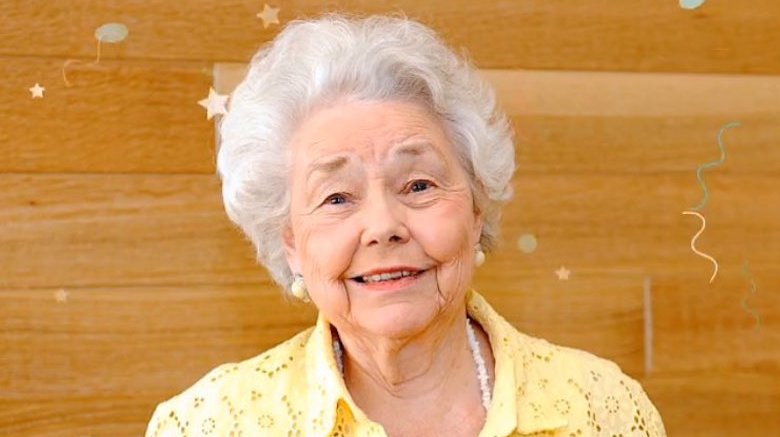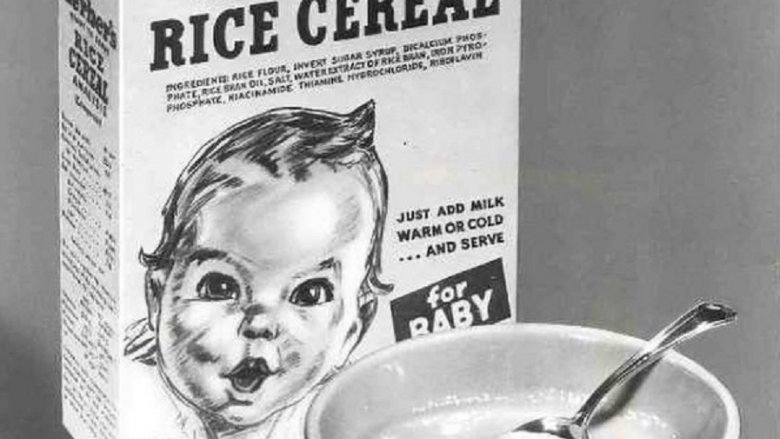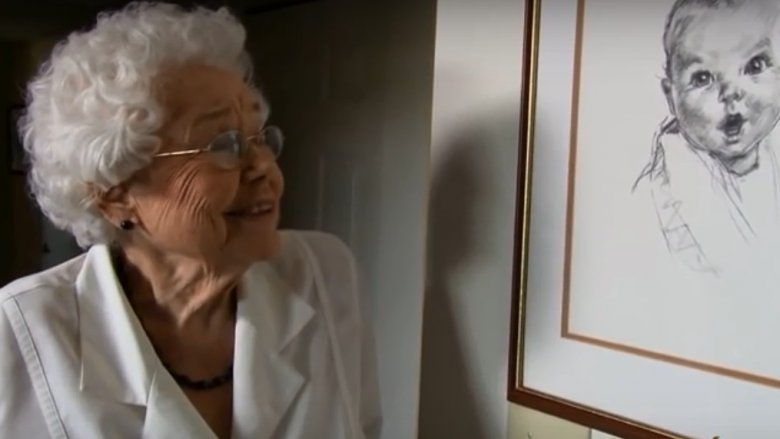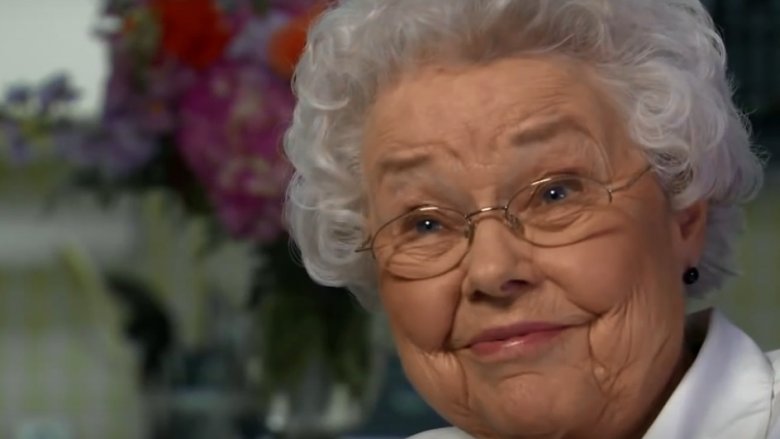The Untold Truth Of The Gerber Baby
For as long as baby food has been sold in American marketplaces, there has been the Gerber Baby. For nearly a century, the cheeky, cherubic face has gazed at customers with big, blue eyes, promising that the ingredients within are best for those you love most. Anyone who's ever parented a child knows the visage of the Gerber food juggernaut well.
But that iconic face wasn't the brainchild of a hotshot marketing executive, nor was it sketched by an advertising design professional. Rather, the blushing babe is in fact a real-life person. Here's the story behind America's most famous baby.
The search started in 1928
In 1928, the folks at Gerber decided to have a contest, and put out a call to artists. That's because they were looking for just the right baby face to feature on the label of their new product: baby food. They received an ample amount of submissions, including some finished oil paintings. However, they opted for the minimalist route, instead selecting an unfinished charcoal sketch as the winner.
The winning artist was Dorothy Hope Smith, who intended to finish the now-famous sketch that she had sent as a sample. But the Gerber execs insisted on leaving it as is. David Yates, vice president of Gerber's North America operations, told the Associated Press, "The logo is the essence of who we are. It is the epitome of a happy, healthy baby and the symbol of trust we have with parents. It's everything to our company."
Gerber trademarked the iconic sketch in 1931 and the company houses it at their corporate headquarters to this day.
And the most recognizable baby face belongs to...
Just who was the baby whose face launched an empire of strained peas and mashed carrots? It turns out that her name is Ann Turner Cook. Born on November 20, 1926, Cook was the 4 month old daughter of Leslie Turner, neighbor of artist Dorothy Hope Smith.
Cook has no difficulty seeing herself in the iconic sketch. In an interview with CBS Sunday Morning, she said, "I always had that expression with my mouth hanging open. Kind of a quizzical expression." Additionally, she's always enjoyed being the face of the company. She continued,"Well when I was very young, I probably was about three years old, when mother pointed out the baby food jar and said that that was my picture. And I thought it was quite a lovely thing."
Cook celebrated her 91st birthday at the end of 2017. A retired teacher, she lives in Tampa, Florida.
A secret identity for 40 years
The real identity of the Gerber Baby is public information now, but that wasn't always the case. In fact, the company kept Cook's identity secret for 40 years, not revealing who she was until 1978.
For a long time, people wondered about the baby's identity. Some speculated that it was actor Humphrey Bogart, and others thought it could be senator Bob Dole. Others thought actress Elizabeth Taylor was the big-eyed babe, or perhaps it was a young Jane Seymour.
Throughout the course of her life, however, Cook didn't fixate on her famous secret. "Most of that time I didn't give much thought to it," she said in an interview for Oprah: Where Are They Now? "All the years when I went to college and so forth, I didn't tell people that I was the model for the Gerber Baby. That would seem a little self-promoting. It's not an achievement of mine, it's the achievement of the artist is the way I look at it."
And of Gerber's motives for keeping her identity under wraps for so long, she said, "Earlier, the Gerber company had not wanted publicity, because if the baby was identified as a girl then little boys would feel that they didn't have representation. They wanted everyone to be able to identify with the baby as their child."
The baby made bank
Cook was paid a lump sum by the Gerber corporation, but not right away. It wasn't until around 1950 that the company compensated her for the first time, when another person came forward claiming to be the Gerber Baby.
In an interview for Oprah: Where Are They Now?, she said, "The first time that I was compensated was at a time that my husband was just had come back from overseas, and he was in the Navy during World War II, and we had absolutely no money at that time. They paid me enough that we could buy our first car, and we made a down payment on a very modest little house. So they gave me a start in our married life."
But Cook still had to work for her entire life. In an interview with Fox and Friends, when asked if she made a dollar every time someone opens a can of strained carrots, she responded, "If I did, I wouldn't have spent 26 years in front of a classroom." Then she laughed.
Additionally, artist Dorothy Hope Smith wasn't paid very much, according to Cook. "I think she was only paid about $300 for the drawing," Cook told Oprah. Cook also believes that Smith is under-appreciated for her work.
A life of mystery
As well-known as she is for being America's most famous baby, Cook has cultivated other passions that are more important to her than her Gerber fame. According to her website, she's pursued two professional endeavors throughout her life that she's proud of.
She taught high school English for 26 years, which is an impressive duration. She's also a novelist several times over. In particular, she writes mystery books, and draws her inspiration for the setting from several locations in Florida.
Her titles include Homosassa Shadows, Shadow Over Cedar Key, Micanopy in Shadow, and Trace Their Shadows. The books feature protagonist Brandy O'Bannon, a newspaper journalist and crime guru.
She admits she "exploits" it a little
Cook has admitted to playing up her Gerber Baby fame in order to draw attention to her novels. In an interview with the Associated Press, she said, "In a way, I might be exploiting it a little. Being the Gerber Baby helps get people interested. I don't think it sells books, but it gets people interested in what I have to say."
Additionally, when she brought a framed copy of the Gerber Baby drawing to a book signing at a Barnes & Noble, she sold ten copies in an hour — clearly, then, the affiliation does get prospective readers' attention.
Representation matters
As America has become more diverse, so too have the babies that have starred in the Gerber company's commercials over the years. That's because diversity in their advertising was needed in order to reflect the changing demographics in the United States.
William Frey, a demographer with the Brookings Institute, told ABC News, "The idea where we had a white, middle-class population that we talked about in the 1950s and 1960s, that's disappearing." So in order to appeal to a more diverse customer base, Gerber started featuring babies of different races and ethnicities in their advertisements.
The new Gerber Baby has Down syndrome
Gerber made history with their 2018 Gerber Baby selection. The winner was Lucas Warren, an 18 month old baby from Dalton, Georgia who won the hearts of the company executives. Bill Partyka, chief executive and president of Gerber, told the Washington Post, "Every year, we choose the baby who best exemplifies Gerber's long-standing heritage of recognizing that every baby is a Gerber baby. This year, Lucas is the perfect fit." Lucas, notably, is the first ever Gerber Baby with Down syndrome.
Cook had kind things to say about the selection, which Gerber shared in a Facebook post. "Let me offer my warmest congratulations to Lucas, our newest Gerber spokesbaby, and to his parents. I know you will take great pride in representing Gerber this year, as I have for the past 90 years," she said.
If anyone knows what an honor it is to be deemed America's most adorable baby, it's Cook. She continued, "There is no greater privilege than to be a universal symbol for babies all over the world. I am delighted to take part in this celebration. Lucas is precious and I look forward to watching him grow this year!"




